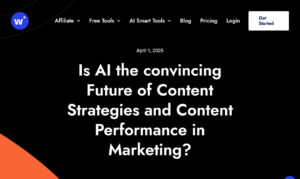It’s no secret: Content is king in the digital world, as it has the power to connect with people and influence decisions. Whether a how-to blog post, a promotional email, or a call to action (CTA) on your landing page, your content can make a difference in your business.
But how do you know if your content works? Does it drive traffic to your website and engage with your potential customers? Does it generate leads and convert sales for your business? That’s where testing and multivariate testing become essential. Whether you’re running a split test, split URL testing, or multivariate test, the goal is to compare and test different versions of your content to see what performs better.
To make confident decisions from your A/B test, ensure your results show clear statistical significance. By using a reliable testing tool, you can measure your conversion rate, track analytics, and determine if your test result is statistically significant. This kind of hypothesis test helps you understand what content resonates best during a marketing campaign. Whether it’s Variant B that gets more clicks or the original that performs better, these tests guide smarter decisions in digital marketing.
In this article, we’ll cover A/B testing and testing methods for your content optimization. Learn how to test multiple versions, design better experiments, and apply principles from machine learning and web search and data mining to your strategy. If you’re testing, these six experiments are a great place to start. Let’s dive right in!
The Importance of A/B Testing for Content Optimization
Time and again, content marketing remains the secret weapon in 2025—and beyond. Pieces of content allow you to boost your online visibility and website traffic. They let you connect with your target audiences and engage with them. They can go as far as generating leads and converting sales for your business.
Case in point: Think of a how-to blog post that takes the top spot on SERP and drives traffic to your website. Consider a promotional email with a compelling CTA that makes prospects interested in buying your goods or items. That is not to mention a convincing case study that converts sales.
It looks like your content pieces do work for your business. But what if they don’t?
There’s no better way than to experiment with your pieces of content as part of your marketing strategies. That’s where A/B testing comes in—learn more about what it is and how it works below.
What is A/B testing?
A/B testing involves testing two types of content to see which one performs better—Is it content A or B? However, the two versions have one variation being tested one at a time. In the end, you choose the content that has a better performance.
For example, your blog post-A consists of an infographic, while blog post-B only contains a statistical image. As you can see, the variation lies in the kind of visual presented on the web page. Here’s what you need to find out:
Which one drives more traffic, generates more leads, and converts more sales?
It’s crucial to factor in the critical elements of an A/B test. Here’s what to keep in mind:
- Single variable: Test one thing at a time so you know exactly what caused the change.
- Tiny tweaks: Even small changes, like a button color, can make a big difference.
- Big changes: Test major elements too, like full landing pages, to see bigger performance shifts.
- Beyond conversions: Look at long-term impacts like leads or sales, not just conversion rates.
- Similar audiences: Keep your test groups alike in size and background to get reliable results.
- Same timing: Run both tests at the same time to avoid seasonal or timing-based bias.
The A/B testing model has become increasingly popular in business across different industries. In fact, companies and organizations go as far as investing in software designed for this testing model. The numbers don’t lie:
The global A/B testing software market is projected to grow from $516.50 million in 2020 to $1249.57 million by 2028at an 11.62% compound annual growth rate (CAGR).

Find out why A/B testing is beneficial for your content marketing below.
Why A/B testing is essential for content
A/B testing should be part of your content optimization process. Test two versions of your content with a slight variation, whether blog content creation, email copywriting, or social media posting. Here’s why it matters:
- Data-driven decision-making: Let your data guide your strategy so you’re not just guessing what works. It helps you make smarter, more confident content choices based on real results.
- Improved content performance: Use A/B testing to see what kind of content actually performs best. That way, you can double down on what resonates and drop what doesn’t.
- Increased audience engagement: Testing helps you figure out what really grabs your audience’s attention. You’ll see more clicks, opens, and interactions with the right tweaks.
- Generated leads and converted sales: When you test and refine, you’re more likely to turn visitors into leads and leads into paying customers. Small improvements can indeed lead to big sales.
- Thought leadership in the industry: Consistently testing and improving your approach helps position you as a smart, data-savvy leader. People notice when the results back your strategy.
According to Liam Bennett, Head of Content at Searqle, “By using A/B testing, you can remove uncertainty and focus on what your audience really reacts to. Even small experiments, like changing the headline, call-to-action button, or content layout, can yield big results. We regularly test various iterations of featured images, intro paragraphs, and internal link placements using tools like AB Tasty and Hotjar. These insights allow us to tailor each post to our readers’ interests.”
Follow the key steps in conducting A/B testing for your content optimization below:
How to set up an A/B testing for content
Content optimization calls for significant improvements but requires strategic execution. What better way to achieve this than to perform A/B testing? However, you need to set it up first—Here’s how:
- Set your content goals in place. Know what you want to achieve—more clicks, signups, or sales—before you run the test. Clear goals keep your efforts focused and meaningful.
- Pick one variation at a time. Only test one change at a time so you can tell exactly what’s working. Mixing changes muddies the results.
- Sort your target audiences. Group your audience by shared traits so your test results are consistent and accurate. Randomizing helps keep things fair.
- Consider the test duration and sample size. Make sure your test runs long enough and reaches enough people to be reliable. Too short or too small, and the results won’t mean much.
- Harness the power of technology. Leverage A/B testing platforms and analytics tools to simplify the process. The right tech can save time and boost accuracy.
Discover the six experiments for content optimization using A/B testing below.
6 Content Experiments for A/B Testing You Should Try Today
The power of content lies in how it resonates with your target audiences and makes them take your desired action. Do they read your blog post, respond to your emails, or subscribe to your channel? If not, you need to employ content optimization!
Fret not; you can leverage automation and AI for your content strategies. These digital tools can assist you with content ideation, outline, research, generation, and optimization. Then, you can proceed with your content experimentation through A/B testing.
That said, here are six content experiments you should try today for your A/B testing:
1. Explore headline variations
When it comes to content, the headline is what your readers see first. It summarizes the entire piece written in one phrase or sentence. Whether it’s your blog title or email subject line, it can catch your target audience’s attention and stir their interest.
So, as far as A/B testing, start experimenting with your content headline. For example, come up with two versions of a particular topic. Then, see which headline variation ranks on SERP and drives traffic to your website. Here are the types of headlines to consider:
- Descriptive: This type clearly explains what something is or what it does, helping people quickly understand it.

- Interrogative: It asks questions to spark curiosity and encourage the audience to think or click for answers.

- Comparative: This approach highlights the difference between two options to show which one is better.

- Benefit-oriented: It focuses on what the audience will gain, making the value instantly clear.

- Opinion-based: This style often shares a viewpoint or stance to spark engagement or build trust.

Raihan Masroor, Founder & CEO at Your Doctors Online, sees the value of a powerful headline for any content. They keep this in mind while maintaining a blog to promote health and well-being and educate their target audiences.
Masroor says, “We test different headline styles to see what actually grabs attention and gets people to click. Your headline is your first impression—it’s what decides whether someone keeps reading or scrolls past.”
2. Try different opening and closing statements
There’s a line drawn between your content introduction and conclusion. While the opening statement introduces what you’ll talk about, your closing statement summarizes what you’ve written. The former determines whether your target audience will continue to read, while the latter seals the deal on whether the audience is satisfied.
As part of your A/B testing, choose a particular topic and write two blog posts with different approaches to their introduction and conclusion. Then, you can check the engagement rates, particularly the number of views, comments, and even shares. Here are different opening and closing statements to consider:
Introduction:
- Hook intro: This grabs attention right away with something bold, surprising, or intriguing.
- Anecdotal intro: It starts with a short story or personal experience to draw readers in.
- Contextual intro: This gives background info to help readers understand why the topic matters.
- Problem-solution intro: It presents a problem and hints at the solution the content will cover.
- Preview intro: This outlines the main points so readers know what’s coming.
Conclusion:
- Summarize the content. Briefly recap what was covered to refresh the reader’s memory.
- Offer recommendations. Suggest the next steps or practical tips your readers can try.
- Have a powerful statement. End with something strong or thought-provoking that sticks with the reader.
- Include a call-to-action (CTA). Encourage readers to do something next—like sign up, read more, or contact you. Take Freedom Debt Relief, for instance, as to how they recommend a debt relief program in each of their blog’s CTA:

3. Make some call-to-action (CTA) changes
CTA does ring a bell in the world of sales and marketing. Short for “call to action,” it’s a prompt that encourages your audience to take your desired action.
It’s usually brief and straightforward, such as “sign up,” “learn more,” “buy now” or “get started.” However, there’s more to it than meets the eye.
A CTA usually consists of the following key elements:
- Clear message: Your CTA should tell people exactly what you want them to do—no confusion.
- Action word: Start with a strong verb like “download,” “subscribe,” or “buy” to prompt action.
- Value Proposition: Briefly explain what the user gets out of clicking, like a free guide or special discount.
- Sense of Urgency: Use time-sensitive words like “now,” “today,” or “limited time” to encourage quicker action.
- Visual Contrast: Make sure the CTA button or link stands out with a bold color or size so it’s easy to spot.
- CTA placement: Put the CTA in a logical, noticeable spot—like above the fold or after key info.
Since CTA can directly impact the conversion rate, most marketers experiment with it for their A/B testing. They develop two CTA versions with slight variations and see which works best in converting sales.
For instance, if you’re offering services or products that involve invoices, test CTAs that link directly to the target action. You can experiment with whether users respond better to links labeled “Create Your First Invoice Now” versus “Free Trial.”

Take it from Fineas Tatar, Co-CEO at Viva, who has his fair share of experimenting with various CTAs for their VA agency. “One often overlooked area for A/B testing is the impact of different calls to action on lead generation forms.”
Tatar suggests, “Experimenting with variations in button text, placement, and the amount of information requested can significantly influence conversion rates. For businesses focused on executive-level engagement, understanding which subtle changes resonate most with their target audience is crucial for optimizing their outreach and maximizing valuable connections.”
4. Consider the length of content
There are different types of content you can experiment with for your A/B testing. Take Forbes Advisor’s list of high-performing content marketing types, such as videos (45%), short-form articles (31%), success stories (28%), long-form blog posts (24%), and case studies (19%).

But regardless of the content types, you can sort them into two categories based on their length:
- Short-form content: Short-form content is quick to read and typically under 1,000 words or just a few minutes long. It’s designed to deliver value fast—perfect for grabbing attention or offering quick updates. Here are a few examples:
- Social media posts
- Emails
- Product descriptions
- Infographics
- Short blog posts
- YouTube Shorts
- TikTok videos
- Long-form content: Long-form content dives deep into a topic and is usually over 1,000 words or several minutes long. It’s great for educating, building authority, and improving SEO by covering a subject thoroughly. Here are some examples:
- In-depth blog articles
- Whitepapers
- eBooks
- Webinars
- Guides
- Case studies
- Long YouTube videos or podcasts
Jacob Barnes, Founder of FlowSavvy, recommends experimenting with the content length for A/B testing. He specifically suggests writing and publishing short and long-form blog content pieces the way they do for their FlowSavvy Blog. “See which one ranks high, drives traffic, engages audiences, and boosts conversions.”
Barnes justifies, “Content length can significantly impact performance, so testing both short and long-form formats is essential. You can make smarter, data-driven decisions that elevate your entire content strategy by analyzing how each performs in terms of traffic, engagement, and conversions.”
5. Experiment with writing tone and style
This one is the most crucial part—experimenting with the writing tone and style. You might want to create evergreen content for long-term traffic, engagement, and conversion. However, you can try different types of content that are best suited for your existing brand and target market.
But since you’re particularly running an A/B testing, you can create two content versions and test them at a time. Here, you compare the two blog posts with different tones and styles and see which works best for your business. Ultimately, this allows you to create a brand voice that resonates with your target audience.
Consider the following approaches to A/B testing:
- Formal vs. conversational: Formal is polished and professional; conversational feels like talking to a friend.
- Serious vs. humorous: Serious keeps it focused; humorous adds personality and fun.
- Authoritative vs. relatable: Authoritative builds trust with facts; relatable connects through shared experiences.
- Straightforward vs. storytelling: Straightforward gets to the point; storytelling adds emotion and depth.
- Data-driven vs. emotion-based: Data-driven uses facts to persuade; emotion-based appeals to feelings.
Tomas Melian, SVP of Marketing at DiabetesTeam, highlights the value of content in connecting with people. However, since they are in the medical field, they prefer their blog to be more professional, authoritative, and data-driven.
Melian shares, “Content is how we engage with people, especially in a space as personal as health. Because we’re in the medical field, we lean toward a more professional, authoritative, and data-driven tone—trust is everything when you’re talking about someone’s health and well-being.”
6. Incorporate various types of visual
When it comes to content, you’d expect a block of text in blog posts or a series of words in marketing ads. However, remember that content can be in the form of a photo or video. So, what better way to optimize your content than to add various visuals?
- Striking images: Images grab attention instantly and can communicate a message faster than words. Whether a bold photo, an eye-catching graphic, or a clear infographic, visuals help break up text, boost engagement, and make your content more memorable.
- Compelling videos: Videos bring your message to life in a dynamic and engaging way. Short-form clips—like TikToks, Reels, and YouTube Shorts—are especially powerful right now because they’re quick, scroll-stopping, and super shareable. That’s why short videos are the most used content formats (over 20% of respondents agreed).

For A/B testing, you can add two types of content for variations—photo images and video clips.
For example, you create two versions of a case study demonstrating how you’ve helped your client achieve their goals. One version should be backed with statistical images showing the results, while the other consists of video clips showcasing the methodologies used. See which version convinces potential clients to do business with you.
Learn from Andrew Bates, COO at Bates Electric, who publishes content testimonials for their electrical services on their website. Recently, they’ve thought about adding client photos and even posting video reviews for trust and credibility.
Bates explains, “Sharing photos or short videos from happy customers helps people feel more confident in what we do. It’s a simple way to show real results and build trust without saying too much.”
Final Words on Test Results and Multivariate Testing
Your content should work wonders for your business. Whether an educational blog post, a promotional email, or a marketing copy, it should promote customer engagement and business growth. What better way to see if it works than to conduct A/B testing, also known as split testing or called split testing or bucket testing?
That said, start by following the key steps for setting up an A/B test outlined above. Make sure you have sufficient data before you test two or more variations. Avoid testing too many variables at once, as it can skew results and make it harder to find clear winners. Instead, focus on specific testing elements like testing subject lines, images, or CTAs. This method, also called split testing, helps maintain clarity and control.
You can run split testing or bucket testing using alternate URLs or testing scripts, or inject testing scripts and markup directly into your page. If you want to try more complex setups, you can use multivariate testing to explore how combinations of elements impact performance.
When it comes to testing, it’s important not to rush or skip steps. Testing without a clear hypothesis or a good testing tool can lead to misleading results. So take your time and make data-driven decisions that truly support your marketing goals.
Then, try some of the content experiments recommended above, whether exploring headline variations, opening and closing statements, or writing tone and style. Effective testing strategies help you optimize every word and make your content shine.
Compare two content versions with slight variations, and see which one connects with people and converts for your business. That’s the power of A/B testing for content optimization! Use Whitecream’s AI-powered tools to help you generate content ideas for your digital marketing strategies. Get started with us today for free!
